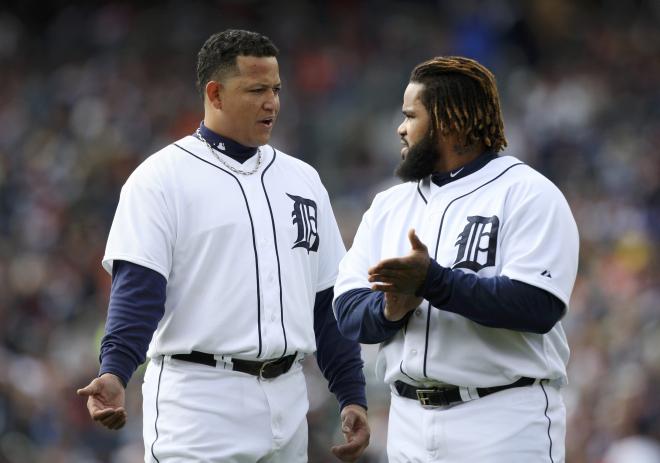 Many predicted the Tigers would reach the World Series. It’s how they got there that no one saw coming.
Many predicted the Tigers would reach the World Series. It’s how they got there that no one saw coming.
The Detroit Tigers reached the postseason with an 88-74 regular season record, posting the fewest wins of any division champion and tying the Cardinals for the fewest among all postseason qualifiers (the Cardinals reached with the NL’s second Wild Card berth). This, after an offseason in which many predicted the Tigers to run away with the AL Central and skate their way to a World Series berth.
While the $214 million offseason acquisition of former Brewers slugger Prince Fielder generated preseason buzz, the Tigers’ lower-half of the lineup went MIA until the final month of the season. However, the inconsistent Detroit squad caught fire at the right time, posting a 15-7 record over their final 20 games before beating back the Athletics and scorching the Yankees with a combined 7-2 postseason record in the ALDS and ALCS series’.
The most popular storylines to emerge from the ALCS have touched on Derek Jeter‘s broken ankle, Alex Rodriguez‘s $30 million benching and how to best fit a portrait photo of the Yankees lineup on the back of a milk carton. But while the famed collapse of the Yankees generates headlines, it is a disservice to a Tigers lineup that features some of the most dangerous weapons in baseball.
Get Big Runs from the Big Bats
Detroit employs two of the finest hitters in the game in Prince Fielder and Miguel Cabrera, and having them hit back-to-back creates a 1-2 pitcher’s nightmare quite unlike anything baseball has seen since Boston’s David Ortiz and Manny Ramirez in the mid-2000s.
Despite the Tigers’ run of success in these playoffs, their two best bats haven’t carried the load.
Cabrera, a candidate for AL MVP and baseball’s first triple-crown winner in over 40 years, is hitting just .278 in nine postseason games with one home run after posting a .330 average and 44 home runs in the regular season. Fielder, Tigers owner Mike Ilitch’s $214 million offseason prize, is hitting just .211 in these playoffs with 3 RBI.
The Giants rotation isn’t what it was in 2010 but it can still put a squeeze on the Tigers’ role players, who have thus far powered the offense. Cabrera and Fielder will need to produce against the likes of Matt Cain, Barry Zito and Ryan Vogelsong.
Duct-Tape Bullpen Must Hold
It’s a good thing Detroit’s rotation has regularly pitched into the seventh inning and beyond. For as good as Verlander and Co. have been, the bullpen has been equally shaky.
Aside from reliever Phil Coke (who was inserted into a makeshift closer role in the ALCS), the Tigers’ bullpen features the likes of a vanishing Jose Valverde, who lost his spot as the closer, and a struggling setup man in Joaquin Benoit.
Detroit’s starters have been dominating through these playoffs, enough so that their embattled bullpen has not been asked to win games, but only to avoid blowing them. San Francisco doesn’t have a murder’s row of hitters, but they’re certainly on par with the Athletics (good luck comparing them to the Yankees, whose plate struggles seem as much self-made as due to the Tigers’ pitching).
Manager Jim Leyland shuffled his bullpen successfully in the ALCS. If he can do just enough with them to avoid giving away wins to the Giants, it’ll be all they can ask them to do.
Continue to Avoid Mistakes in the Field
For as good as Cabrera and Fielder are at the plate, they may be equally unreliable in the field.
However, those two are just low-hanging fruit when it comes to identifying the Tigers’ struggles in the field. Detroit finished with one of the league’s five-worst defenses in the regular season no matter how you slice it.
While Detroit has two fewer errors this postseason than the Giants (four, to San Francisco’s six), their fielding percentage is only marginally better (.988 to .986) because the Giants have played three more games.
Outfielder Delmon Young and second baseman Omar Infante, though their bats have been red-hot through the first seven games, are also liabilities in the field.
Detroit has to continue their run of good postseason defense to hold off the Giants.
Continue to Get Stellar Starting Pitching
The Tigers have lived and died by their starters, who thus far have been better than advertised.
Justin Verlander, who will take the mound in Game 1 and on plenty of rest, will likely make two appearances in the series and could potentially go three if it reaches a seventh game and the Tigers struggle to get there.
In three starts this postseason, Verlander is 3-0 with 24.1 innings pitched, two earned runs, five walks, 25 strikeouts, a .74 ERA, .122 batting average against and one complete game shutout.
Max Scherzer, Anibal Sanchez and Doug Fister, Detroit’s other three starters, have postseason ERA’s of .82, 1.35 and 1.35, respectively, and Sanchez is the only Detroit starter to post a loss in these playoffs.
It’s a tall order, but if they stay on par with what they’ve done thus far, Detroit’s rotation can carry them to a World Series win.
Put the Giants Away
It’s a tall task, one that the St. Louis Cardinals and Cincinnati Reds failed to accomplish in six attempts. The Giants fell into holes of 0-2 and 1-3 in their first two postseason series’ and have won all six elimination games they then had to play, including dropping three of the four home games they had to open both series’.
The Giants will again start at home against Detroit.
For the Tigers, taking the Series in short order could be the missing ingredient to winning it all. The Giants have proven to become stronger as a series progresses, winning the final three games of each series they’ve played so far.
A sweep isn’t out of the realm of possibility, given Detroit’s rotation, but it shouldn’t be a necessity, either. As long as the staff provides starting pitch anything close to what they’ve given so far, and the bullpen stays in one piece, the Tigers should have the inside track to their first World Series title under Leyland.
